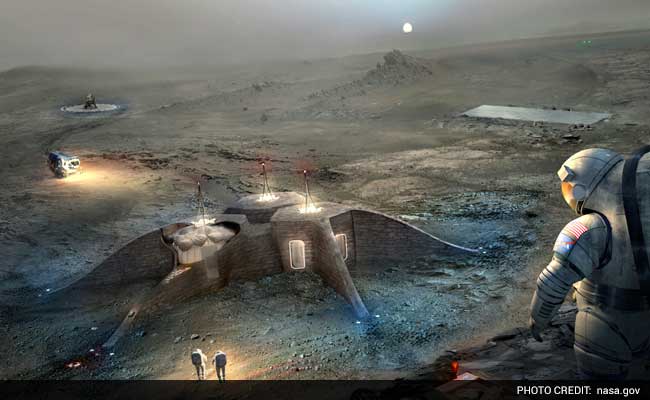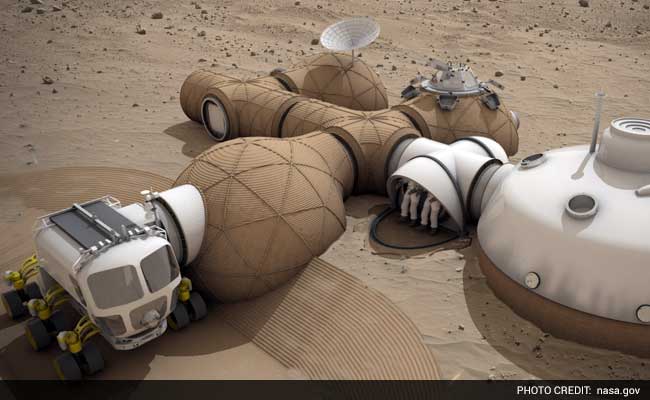
New Yorks Team Space Exploration Architecture and Clouds Architecture Office was awarded the first prize for their design, Mars Ice House.
New York:
A 3D printed ice shelter designed for Mars, which aims to rely on the red planet's predicted liquid water and low temperatures, has won the first-place award of $25,000 in NASA's Mars habitat design competition.
NASA has awarded a total of $40,000 in the first stage of the 3-D Printed Habitat Challenge Design Competition.
The design competition challenged participants to develop architectural concepts that take advantage of the unique capabilities 3-D printing offers to imagine what habitats on Mars might look like using this technology and in-situ resources.
 More than 165 submissions were received and 30 highest-scoring entries were judged. The first-place award of $25,000 went to Team Space Exploration Architecture and Clouds Architecture Office for their design, Mars Ice House.
More than 165 submissions were received and 30 highest-scoring entries were judged. The first-place award of $25,000 went to Team Space Exploration Architecture and Clouds Architecture Office for their design, Mars Ice House.
"Given the predicted abundance of water in certain areas on Mars, our approach takes full advantage of its properties as an indigenous material that acts both as a life-force to sustain a human and plant ecosystem, and, when 3D printed, as our primary fabrication material," the team said.
As water is a means of sustaining life and ice a potential building material, the team opted to locate at Alba Mons in Mars' northern hemisphere, where it is believed sub-surface water ice is plentiful.
 The proposal uses a lander as the basis of the shelter, containing both private and communal interior spaces. Once in situ, it would deploy an inflatable membrane to create an interstitial environment between the outside of the capsule and the Mars atmosphere.
The proposal uses a lander as the basis of the shelter, containing both private and communal interior spaces. Once in situ, it would deploy an inflatable membrane to create an interstitial environment between the outside of the capsule and the Mars atmosphere.
Rovers would then extract water from the ice below the surface at Alba Mons and apply it to form a protective skin on the inside of the inflatable environment.
The layer of ice would provide protection from radiation in the outside atmosphere, and it would also be translucent and allow light into the habitat, 'Gizmag' reported.
By conditioning the environment within the inflatable section, it is proposed that the ice be kept frozen indefinitely and vegetation could be grown, which would help to convert carbon dioxide into oxygen.
NASA has awarded a total of $40,000 in the first stage of the 3-D Printed Habitat Challenge Design Competition.
The design competition challenged participants to develop architectural concepts that take advantage of the unique capabilities 3-D printing offers to imagine what habitats on Mars might look like using this technology and in-situ resources.

Second place and $15,000 was awarded to Team Gamma for their habitat design.
"Given the predicted abundance of water in certain areas on Mars, our approach takes full advantage of its properties as an indigenous material that acts both as a life-force to sustain a human and plant ecosystem, and, when 3D printed, as our primary fabrication material," the team said.
As water is a means of sustaining life and ice a potential building material, the team opted to locate at Alba Mons in Mars' northern hemisphere, where it is believed sub-surface water ice is plentiful.

Team LavaHive was awarded third place honors for their Mars habitat design.
Rovers would then extract water from the ice below the surface at Alba Mons and apply it to form a protective skin on the inside of the inflatable environment.
The layer of ice would provide protection from radiation in the outside atmosphere, and it would also be translucent and allow light into the habitat, 'Gizmag' reported.
By conditioning the environment within the inflatable section, it is proposed that the ice be kept frozen indefinitely and vegetation could be grown, which would help to convert carbon dioxide into oxygen.
Track Latest News Live on NDTV.com and get news updates from India and around the world

